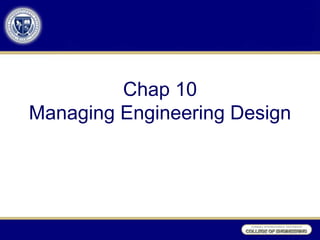The document discusses the key stages in engineering design and new product development processes:
1) The conceptual stage involves defining the problem, requirements, constraints and potential solutions at a high level. This stage has the lowest cost but highest impact on the final product's lifecycle costs.
2) The technical feasibility stage confirms that a solution can meet requirements through testing while identifying any barriers. This stage determines around 85% of lifecycle costs.
3) Later stages include development of prototypes, commercial validation, full production, product support, and eventual disposal. Concurrent engineering approaches integrate these stages to speed development and reduce costs.





















































